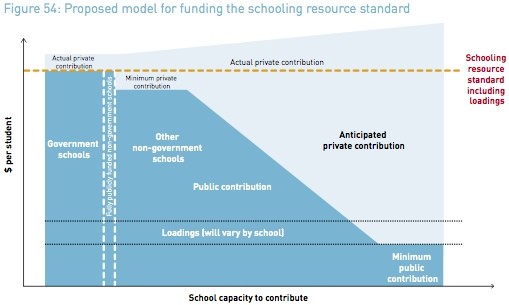The Gonski education funding review has proposed a significant overhaul of school funding to the federal government to replace a complex, incoherent and non-transparent funding system with a per-student funding model and a new approach to school capital funding that would cost up to $5b pa extra beyond current funding from all levels of government.
A review panel headed by David Gonski submitted the report to the government in December, but the matter will be referred to COAG and an extensive consultation process, enabling the issue to be further deferred by a government deeply worried about being seen to remove funding from private schools.
The review has found that Australia’s hitherto-strong educational performance has declined over the last decade, with Australia slipping from second in reading and scientific literacy and third in Australia in mathematical literacy to seventh and 13th. There is also a significant gap between our highest and lowest performing students.
The review also found that current arrangements — a combination of state government funding arrangements and the Howard government’s funding based on a Socioeconomic Status model — are “unnecessarily complex, lack coherence and transparency, and involve a duplication of funding effort in some areas”, that wasn’t balanced between the Commonwealth and the states.
Critically, current arrangements are also based on a flawed Average Government School Recurrent Costs model, which is unrelated to schooling outcomes, features confusing indexation arrangements and uncoordinated capital investment.
The Gonski funding model, based on a schooling resource standard, would commence from 2014 and would apply across all schooling sectors. It would be composed of
- a per student funding amount for primary and secondary school students, regardless of sector;
- the set student funding amount would be benchmark-based, set according to current resources used by schools producing high educational outcomes;
- the amount would be adjusted via loadings for additional costs reflecting socioeconomic background, disability, English language proficiency, the needs of Indigenous students, size, and location;
- be reviewed quadrennially;
- be indexed based on the actual costs in high-performing schools;
- government schools would be fully publicly funded to the level of the schooling resource standard, appropriately adjusted according to loadings;
- for non-government schools, public funding would reflect anticipated private contributions to each school, based on the current socioeconomic status (SES) score of the school; and
- reflecting its current level of funding, the Commonwealth would contribute around 30% of all funding.
The review recommends that a tool be developed to more accurately assess ability to contribute to private schools, but that it should be assumed the poorest-ranked schools would be able to access a 10% private contribution and the best-ranked schools between 75-80% private contribution — that is, no school would receive less than 20-25% per student public funding (which will enable the government to claim no school will lose funding).
The review also proposes greater coordination by bodies within the government and non-government sector of capital funding, with projects assessed by authorities within each sector, overseen by a single planning authority within each state. A new National Schools Resourcing Body would oversee the new funding arrangements.
The panel calculated, using 2009 figures, that if new funding model had been in place during 2009, it would have cost government governments would have been about $5 billion, an increase of 15 per cent.
The government will seek to negotiate the new funding proposals through COAG, including via a number of working groups and through a consultation process, via a Ministerial Reference Group, will be established to test the new funding model and other aspects of the reforms.
The new model is currently scheduled to commence form 2014.
Related stories:









The Australian Government should change its grant to private schools to an income contingent loan (like Hecs) to parents to pay private school fees. This would allow all parents who were willing to take out a loan to pay private school fees but would require them to repay the loan once their income was above a threshold, which for Hecs is a taxable income of $47,196 annually.
Sorry: I forgot to start by thanking you and Crikey for this timely and informative piece.
Thank you for this simple exposition of what, even with common sense and goodwill, both in lamentably short supply, would be very complex but essential reforms. We need to remember this guide as the coming disinformation campaign is launched by the private school lobby with the support of the Coalition and a large tranche of the media.